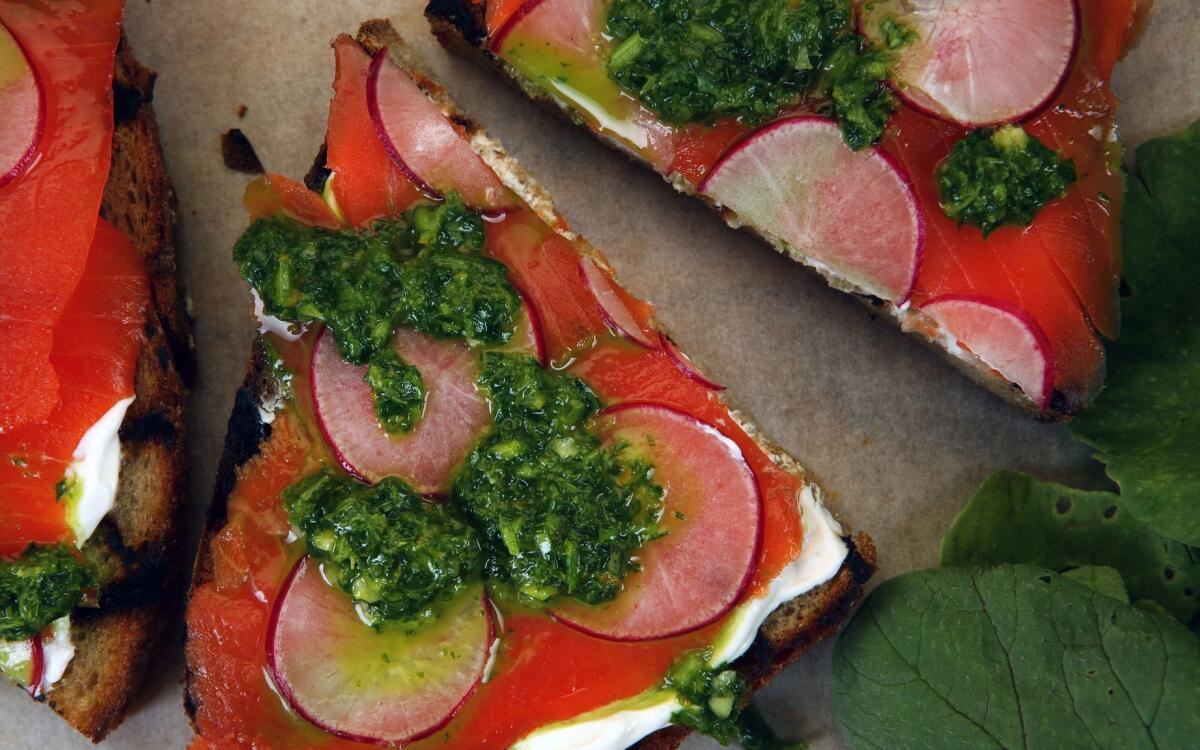Radish, salmon and radish green salsa verde toasts

- Share via
Many years ago, I ran into Alain Giraud, one of the best French chefs in Los Angeles, rummaging through crates of discarded vegetable greens at the Wednesday Santa Monica farmers market. This was a good decade before food waste became the sort of thing people talked about on high profile panels and in beautiful documentaries. Giraud doubtless already knew to use his kitchen’s parsley stems and fennel fronds in stock, as any classically trained chef would, so I ducked under the table and asked him what he was doing.
“It is for my rabbits,” the chef said in his thick Parisian accent, tucking a thatch of bright green carrot tops into the straw market basket under his arm, along with bouquets of lavender and chervil.
I remember this for many reasons. Because it was incredibly charming, of course, but also because my daughter used the story years later to guilt me into letting her get her own pet rabbits, which we have fed with discarded farmers market greens ever since. It was also an object lesson in free pet food and the accidental, often invisible treasures of farmers markets. Not only can you feed your kid’s permanently hungry rescued rabbits with the stuff but you can make your own dinner out of it too.
We throw an enormous percentage of food away, not only wasting food we know about but also food we don’t think of as being part of the farm-to-table sequence. Sometimes, when I’m at my neighborhood farmers market pulling beet greens and carrot tops out of the discard bins behind the produce stalls, someone will ask me what I’m doing with them. Or, more often, they’ll ask the nearby farmer whether the tops of the various vegetables they’re buying are edible.
Fresh greens are gorgeous, fragrant, healthful and enormously flavorful; they’re also endlessly useful in cooking. Not only do we use herbs and greens in soups, salads, sauces and stocks, but also in bouquets garnis, as garnishes, even in cocktails. Why we value some more than others is pretty arbitrary.
Until relatively recently, many of the pricey, sought-after and hard-to-find greens at markets were considered weeds: Farmers used to throw out stinging nettles, lamb’s quarters and nasturtiums instead of selling them. Similarly, the green tops of various vegetables were often tossed into soups or stocks by thrifty cooks, but they’ve now found their way into mainstream kitchens and restaurant menus, often by chefs who want to draw attention to the issue of food waste or who apply nose-to-tail principles to plants. Of course, many have been using every part of a plant or vegetable for generations, much as they’ve been foraging for much longer (decades, millenniums) than it’s been considered trendy.
“Food waste is partly a value judgment about what is desirable and what is not,” Danish chef Mads Refslund, one of the founders of the Copenhagen restaurant Noma, writes in the preface to his recent cookbook, “Scraps, Wilt + Weeds.” Refslund includes some pretty desirable dishes in his book: daikon pea dumplings, spruce sugar cookies and a pesto made with carrot tops — they taste rather like bitter frisée, with a hint of, you guessed it, carrot — that I like to serve with the carrots that come with those tops, roasted in the oven with olive oil and salt. Refslund is just one of many notable chefs who are folding recipes for these forgotten bits into their cookbooks. Portland, Ore.-based Jenn Louis devotes an entire chapter to them in her new book, “The Book of Greens.” “As a rule,” Louis writes, “don’t overlook anything green on a root, fruit or vegetable.” Among her highly desirable dishes: pasta made with tomato leaves and sherbet made from celery leaves.
If making dessert out of your rabbits’ food feels a little too ambitious, treat these greens as you would parsley or other conventional herbs. Blend them into pesto, salsa verde, chimichurri and other sauces and salsas. Even simpler: Toss them directly into salads and maybe whisk some of them into a vinaigrette.
Hardier greens, such as those atop beets, turnips and radishes, can be wilted and added to soup or pasta or folded into tacos. Combining the greens with the vegetables attached to them is happily symmetrical. So, load goat cheese quesadillas with both roasted beets and sauteed beet greens. Thinly sliced radishes make great sandwiches — with butter and sea salt, or smoked salmon and crème fraîche — on slabs of thick, rustic bread. Turn the radish tops, which have a peppery tang to them reminiscent of arugula, into a vibrant salsa verde. Drizzle over toast or stir into crème fraîche (or yogurt or cream cheese) to brighten both the flavor and the color.
The leafy tops of fennel have an anise-y flavor, not unlike the dill they resemble, and are terrific in salads and with salmon and cucumber. Celeriac leaves look and taste like a more hardcore version of celery and thus work well in potato salads and soups.
If you’re not familiar with the greens, taste them and consider what dishes you might like. You could also do worse than strike up a conversation with the farmer at the produce stand — or whomever is digging through those piles of carrot tops and radish greens.
Radish green salsa verde
In a food processor or blender, combine the radish greens, cilantro, oil, garlic, a pinch of salt (or to taste), lemon zest and juice, and orange zest and juice. Blend until smooth. This makes about 1½ cups salsa verde.
Assembly
Divide the crème fraîche among the toasted bread slices, spreading it evenly over each piece. Top with the salmon, followed by the radish slices. Drizzle or spoon over the salsa verde and serve immediately.
Get our Cooking newsletter.
Your roundup of inspiring recipes and kitchen tricks.
You may occasionally receive promotional content from the Los Angeles Times.
















